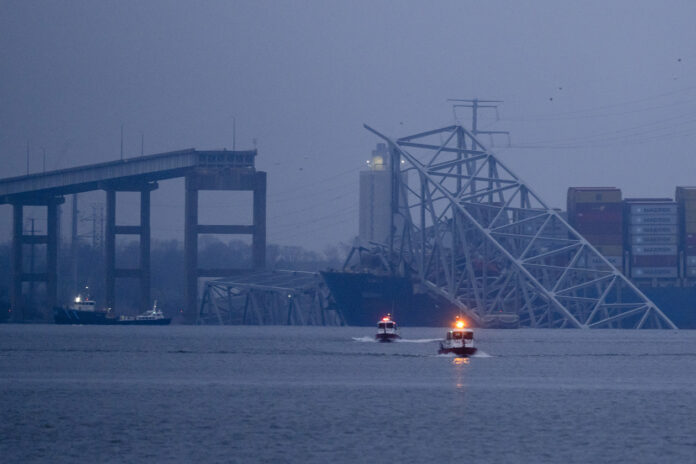The cause of the container ship crash into the Francis Scott Key Bridge in Baltimore is only now being investigated by federal authorities. But hints are starting to pop up, so long as you have the knack for deciphering them.
Dive teams successfully recovered the ship’s data recorders early Wednesday morning. National Transportation Safety Board chair Jennifer Homendy said her team would be collecting any components, electronic logs, paperwork, photographs, and other items needed for its investigation at the scene in Baltimore. These items must be collected before clean-up operations can begin.
That is only the beginning of a probe that might take a year or more.
What follows is HEADLINESFOREVER’s rundown of upcoming events and shows.
Where does one begin with the investigation?
As the effort’s leader, the National Transportation Safety Board (NTSB) will investigate incidents and provide recommendations to prevent them.
As it prepares its final report, the NTSB will examine many issues, including the ship’s and bridge’s maintenance records, the data recorder aboard the ship, the crew’s behaviour, the design of the bridge, emergency procedures, and many more.
According to safety expert and ex-NTSB investigator Jeff Guzzetti, the agency’s primary objective is to gather “perishable evidence” (i.e., data that will vanish once the scene is cleaned up).
According to Guzzetti, “that includes peoples’ memories.” Therefore, it is expected that the crew of the Dali and anyone who may have performed recent engine and electrical system maintenance would be interviewed.
Operations, weather, engineering, recorded data, individuals involved, and “other disciplines that are germane to shipping accidents like this” will be among the many variables that the NTSB’s expert groups will investigate, according to Guzzetti.
“The gathering of the data requires some time,” Homendy stated. “Right now, we’re here to gather information and data, the evidence that will expire soon.”
Is there anything that might point to where things went wrong?
Yes, in a nutshell, but usually a series of interconnected failures in the transportation sector is to blame for accidents of this scale.
This is not going to be easy, Guzzetti assured them.
It seems like the ship’s power went out and its propulsion went out at the worst possible time.
Shots of the harbour shot that fateful night show the Dali hurtling towards the bridge, which it slammed into with a horrifying spray of sparks. Just before it hits the bridge, the ship’s lights cycle on and off, and a large cloud of smoke shoots out from one of its stacks.
“Something mechanically went wrong,” Guzzetti added, adding that it seemed like the crew lost control of the ship’s direction. “People have been saying that it could be bad fuel. If the fuel isn’t working, the engines won’t produce electricity, and you won’t be able to steer.”
Mechanical failure, or failures, aboard the ship, would likely be a major focus of the investigation, according to Guzzetti.
According to him, there was clearly a problem with the ship because of the lights going on and off just before impact, the black, acidic fumes coming out of the stack, and the sudden loss of steering control and movement. “What happened and why they lost control will be precisely investigated.”
The ship had reported a “momentary loss of propulsion” to the Singapore Maritime & Port Authority just before the incident, according to their findings.
Although its design is under scrutiny, the Francis Scott Key bridge does not appear to have been in bad shape.
The bridge itself does not seem to have been a contributing factor to the accident at this time. At a news conference earlier this week, Maryland Governor Wes Moore declared the bridge to be “completely up to code.”
Nevertheless, there are doubts over the feasibility of installing “fenders” (also known as “dolphins”) around the support beams of the 1977-built bridge. The Key Bridge was constructed in 1977 without these fenders, which are designed to divert ships that aren’t supposed to be there from those beams.
Buttigieg, the secretary of transportation, stated on Tuesday that no bridge could have survived the collision.
“As far as I am aware, no bridge has ever been built to endure the force of an impact from a ship of this magnitude,” he declared. Buttigieg likened the vessel to a “Nimitz-class aircraft carrier, going directly into the key support beam of that bridge” on Wednesday.
A “highway safety team on board to begin to look at the structure and identify any components that they need to send back to our lab,” according to Homendy, who announced her agency’s plans on Wednesday morning.
Many lives were spared thanks to the crew’s mayday signal and the response time of the police.
Sometime before the ship struck the bridge, the crew or harbour pilot realised they were in serious difficulty and sent out a “mayday” radio signal to authorities, warning that calamity was imminent.
With that little window of opportunity, authorities were able to block both bridge lanes, preventing a potentially catastrophic increase in casualties.
The bridge collapsed moments after the responding police considered radioing the construction crew to leave. There was a probable death toll of six workmen when the bridge collapsed.
Bridge Collapse Probe: Key Points to Monitor…
